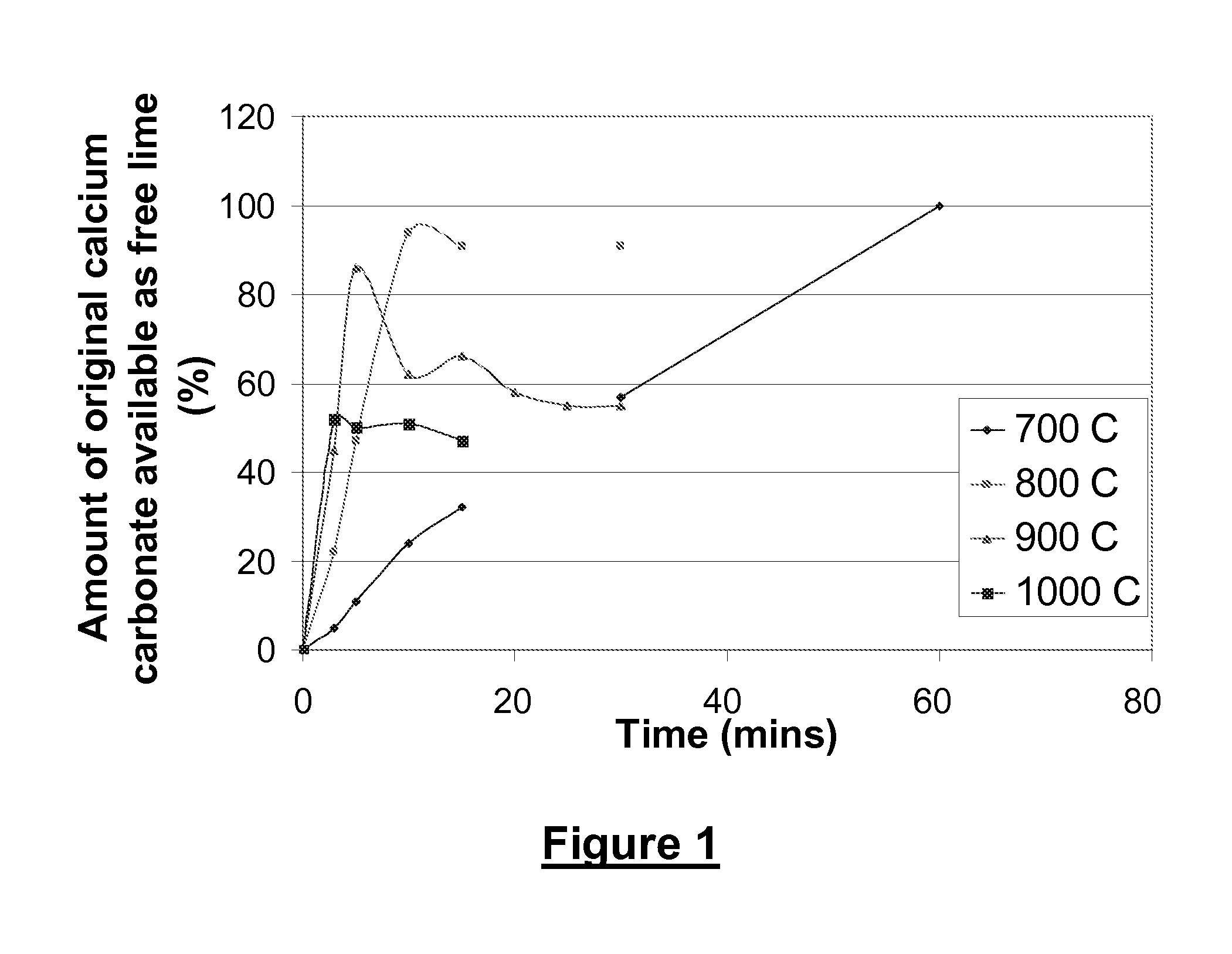Production and/or recovery of products from waste sludge
- Summary
- Abstract
- Description
- Claims
- Application Information
AI Technical Summary
Benefits of technology
Problems solved by technology
Method used
Image
Examples
example 1
[0123]This Example demonstrates how temperature and time affect the composition of an ash obtained from a paper sludge, in terms of the amount of freely available calcium oxide present in the sludge.
[0124]Paper sludge from a German papermill using de-inked fibre was combusted for varying times at temperatures of 700° C., 800° C., 900° C. and 1000° C. by placing 50 g samples in a laboratory electric furnace. To reduce the material bed depth and improve heat flow, the small sample was spread evenly on a large tray.
[0125]The influence of these combustion conditions on the amount of freely available calcium oxide in the PSA was determined by adding 8.799 g of ash to 250 g of aqueous solution containing 25% of sorbitol. The mixture was then stirred in a 1 litre laboratory beaker for 30 minutes and the insoluble material removed by filtration using a Buchner funnel. The remaining clear filtrate was titrated with 0.1 molar hydrochloric acid to determine the concentration of calcium hydroxi...
example 2
[0130]150 g of deinking sludge from Aylesford Newsprint was heated in a laboratory furnace under atmospheric conditions. An initial heating at 600° C. for 15 minutes served to dry and burn the organic components of the sludge. This was immediately followed by a second heating stage of 2 hours at 800° C. to ensure that all the calcium carbonate contained within the sludge was decomposed to calcium oxide. The resulting ash was then allowed to cool and then milled for 1 minute in a Janke & Kunkel mill.
[0131]XRD analysis of this PSA confirmed that all the calcium carbonate was decomposed and that no glassy complex silicates were formed. The PSA was of the following composition:
60% Lime (CaO & Ca(OH)2)*
1% Quartz
[0132]39% amorphous metakaolin
[0133]Some hydration occurred as the hot ash cooled in a humid atmosphere.
[0134]30 g of the milled powder was added directly to 505 g of an aqueous solution containing 25% by weight of sorbitol.
[0135]The mixture was stirred for 30 ...
example 3
Comparative
[0143]Paper Sludge Ash (PSA) from Aylesford Newsprint was characterised as having a brightness (R457) of 68% and a very broad particles size between 1 and 200 microns. This PSA has an approximate composition measured by XRD of.
25% Lime (CaO & Ca(OH)2))
17% Calcium Carbonate (CaCO3)
9% Gehlenite
16% Larnite
3% Calcium Aluminate
1% Quartz
[0144]28% amorphous metakaolin (Al2Si2O7)
[0145]The following Table 2 demonstrates the equivalent amount of CaO (expressed as a percentage of the weight of the ash) provided by each of the above components.
TABLE 2ComponentEquivalent CaO (%)Lime (expressed as CaO)23.4Ca(OH)21.6Calcium Carbonate9.7Gehlenite3.6Larnite10.8Calcium Aluminate1.3Quartz—Metakaolin—
[0146]Thus the ash contained 50.4% by weight equivalent lime which (for 100 g of ash) represents 90 g of calcium carbonate in the original sludge (i.e. (50.4 / 56)*100, where 56 represents the formula weight of calcium oxide and 100 represents the formula weight of calcium carbonate).
[0147]Of this...
PUM
| Property | Measurement | Unit |
|---|---|---|
| Temperature | aaaaa | aaaaa |
| Fraction | aaaaa | aaaaa |
| Fraction | aaaaa | aaaaa |
Abstract
Description
Claims
Application Information
 Login to View More
Login to View More - R&D
- Intellectual Property
- Life Sciences
- Materials
- Tech Scout
- Unparalleled Data Quality
- Higher Quality Content
- 60% Fewer Hallucinations
Browse by: Latest US Patents, China's latest patents, Technical Efficacy Thesaurus, Application Domain, Technology Topic, Popular Technical Reports.
© 2025 PatSnap. All rights reserved.Legal|Privacy policy|Modern Slavery Act Transparency Statement|Sitemap|About US| Contact US: help@patsnap.com

